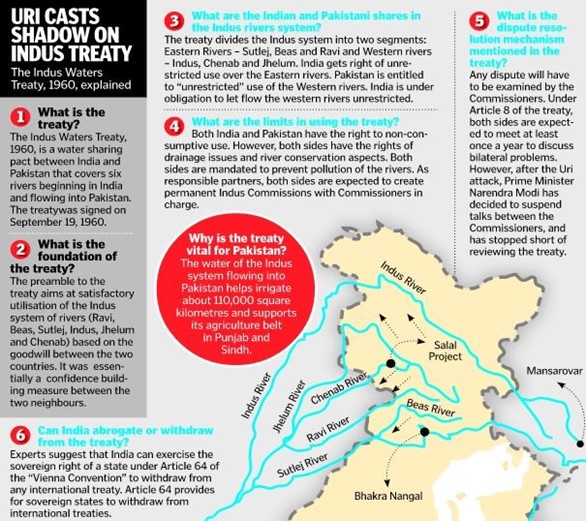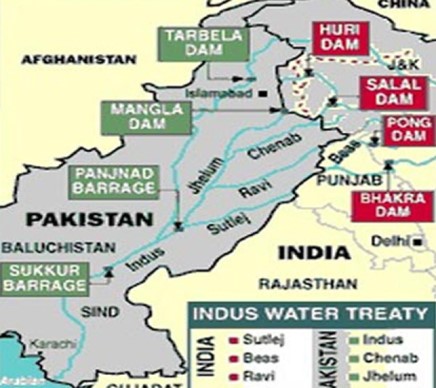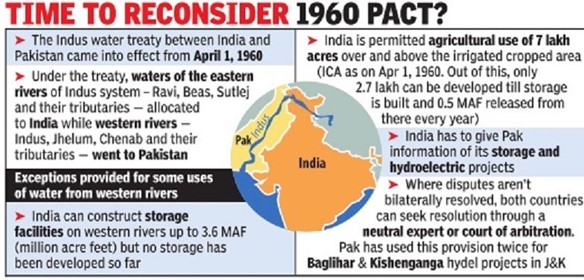Contents:
- Indus Water Treaty: Navigating Renewed Disputes Amid Growing Water and Climate Challenges
- New Criminal Codes, Old Challenges: Addressing Infrastructure and Capacity Deficits
- India’s Role in Russia-Ukraine Peace-Making: A Balancing Act
Indus Water Treaty: Navigating Renewed Disputes Amid Growing Water and Climate Challenges
Context: The Indus Waters Treaty (IWT), signed in 1960 between India and Pakistan, is a landmark agreement that has withstood wars, terrorism, and diplomatic tensions. However, recent developments, including India’s plans to modify the treaty and disputes over hydroelectric projects like the Kishanganga and Ratle dams, have brought renewed attention to the agreement.

Relevance: General Studies Paper II (International Relations)
Mains Question: Discuss the significance of the Indus Waters Treaty for India and Pakistan. Analyze the challenges posed by recent developments in the context of hydroelectric projects and climate change.

- Overview of the Indus Waters Treaty:
- The Indus Waters Treaty (IWT), brokered by the World Bank, governs the sharing of the waters of the Indus River system. The treaty allocates the waters of the eastern rivers (Ravi, Beas, Sutlej) to India and the western rivers (Indus, Jhelum, Chenab) to Pakistan, with certain allowances for India to use western rivers for non-consumptive purposes like hydroelectric projects.
- The treaty has been largely successful, surviving multiple conflicts between the two nations and acting as a stabilizing factor in their bilateral relationship.

- Recent Disputes Over Hydroelectric Projects:
- India’s Kishanganga (330 MW) and Ratle (850 MW) hydroelectric projects on the Jhelum and Chenab rivers, respectively, have been points of contention. Pakistan objects to these projects, arguing that they violate the treaty by impacting water flow.
- In 2013, the Permanent Court of Arbitration (PCA) at The Hague ruled in favor of India’s Kishanganga project, allowing India to divert a portion of the Jhelum’s waters for power generation. However, Pakistan has continued to raise objections regarding the construction and operation of these projects, leading to further diplomatic tensions.
- India’s Call for Review and Modification:
- In 2022, India issued a notice to Pakistan requesting a review and modification of the 62-year-old treaty. India argues that the treaty needs updating to reflect current realities, including climate change, new technological advancements, and the need for water security amid growing population pressures and development demands.
- India also seeks to accelerate the construction of renewable energy projects, including hydropower, to meet its climate goals. Projects like Ratle are seen as essential for India’s renewable energy agenda.
- Pakistan’s Response and Arbitration Attempts:
- Pakistan, in response, has refused to engage in bilateral negotiations, seeking third-party arbitration instead. In 2015, Pakistan had initiated arbitration under the IWT but later withdrew its application.
- The involvement of the World Bank as a mediator in these disputes has been met with limited success, and India has argued that certain matters, such as the adjudication of disputes over Kishanganga and Ratle, should not involve international arbitration bodies.
- Climate Change and Water Scarcity:
- The IWT’s core principle of “water doesn’t recognize borders” is increasingly strained as climate change worsens water availability. Pakistan has repeatedly raised concerns about water scarcity, with many of its rivers dependent on flows originating in India.
- Both nations face significant challenges from glacial melt in the Himalayas and changing rainfall patterns, making the Indus River system even more vital for agriculture, drinking water, and power generation. The growing effects of climate change necessitate updates to water-sharing agreements like the IWT to ensure long-term sustainability.

Additional Data:
- Kishanganga Project: 330 MW (India won arbitration at the PCA in 2013).
- Ratle Project: 850 MW (India’s upcoming project on the Chenab).
Conclusion:
The Indus Waters Treaty has served as a successful mechanism for managing water disputes between India and Pakistan for over six decades. However, recent hydroelectric projects, coupled with the impacts of climate change, have brought renewed challenges to the treaty’s implementation. Both nations need to approach these disputes cautiously, emphasizing diplomatic negotiations and joint management strategies to address shared water challenges in a rapidly changing environment.

New Criminal Codes, Old Challenges: Addressing Infrastructure and Capacity Deficits
Context: India has introduced new criminal laws, including the Bharatiya Nyaya Sanhita (BNS), Bharatiya Nagrik Suraksha Sanhita (BNSS), and Bharatiya Sakshya Adhiniyam (BSA). These laws aim to modernize India’s criminal justice system by streamlining procedures, improving evidence-based investigations, and protecting public rights. However, the success of these new laws will hinge on resolving infrastructure deficits, human resource shortages, and knowledge gaps within the judicial and law enforcement systems.
Relevance: General Studies (GS) Paper II (Governance and Social Justice)
Mains Question: Evaluate the challenges in implementing India’s new criminal laws. How can infrastructure and human resource deficits be addressed to ensure effective law enforcement?
- The New Criminal Laws: Overview and Intent:
- The Bharatiya Nyaya Sanhita (BNS), Bharatiya Nagrik Suraksha Sanhita (BNSS), and Bharatiya Sakshya Adhiniyam (BSA) aim to replace outdated colonial-era laws such as the Indian Penal Code (IPC), Criminal Procedure Code (CrPC), and Evidence Act.
- These laws emphasize speedier trials, ensuring that judgments must be delivered within 45 days of trial completion, and chargesheets should be framed within 60 days of the first hearing.
- However, the primary concern lies in whether the judicial and enforcement systems have the capacity and infrastructure to meet these stringent timelines.
- Key Challenges in Implementation:
- Judicial Backlogs: As per the National Judicial Data Grid (NJDG), India has over 5.1 crore cases pending across courts. The case burden per judge rose from 2,391 in 2022 to 2,744 in 2024. With the introduction of new laws requiring stricter timelines, courts will need additional judges, support staff, and better infrastructure.
- Undertrial Prisoners: A significant number of undertrial prisoners await investigation, contributing to overcrowded prisons. The prison occupancy rate rose from 137% to 142% between 2022 and 2024. The quicker processing of cases will require increased infrastructure to house and manage this transition.
- Forensic and Investigative Capacities: The new laws stress the importance of evidence-based law enforcement. However, India faces chronic shortages of trained forensic professionals, laboratory capacity, and technological equipment to match these new requirements. There is a significant mismatch between human resources and available forensic infrastructure.
- Inadequate Budget for Judiciary and Law Enforcement:
- Despite the government’s efforts to address infrastructure gaps, such as the launch of the National Forensic Infrastructure Enhancement Scheme, judicial and law enforcement funding remains inadequate.
- The budget allocation for the judiciary in 2022 and 2023 did not keep pace with increases in case GDP, limiting the scope for major improvements in infrastructure. Vacancies in high courts remain high, with a 21% vacancy rate, further straining the system.
- Addressing Infrastructure and Capacity Deficits:
- Human Resource Development: There is an urgent need to recruit more judges, forensic experts, and administrative staff. Expanding training facilities and developing specialized courses for forensic and investigative personnel will improve the enforcement of new laws.
- Technology and Infrastructure Investments: Investments in technology to digitize case records, manage data, and improve case management systems will be essential. The government must allocate funds to expand forensic laboratories and enhance court infrastructure, ensuring they can meet the increased demands posed by the new laws.
- Collaboration with Civil Society: The implementation of the BNSS also mandates victim services, which include creating digital records of interviews. Civil society can assist in monitoring and ensuring that the rights of victims are upheld during trials.
Additional Data:
- Pending Cases: Over 5.1 crore cases are pending in India’s courts.
- Judicial Vacancy: 21% vacancy rate in lower courts as of 2023.
- Prison Occupancy Rate: Increased from 137% to 142% between 2022-24.
Conclusion:
India’s new criminal laws represent a critical step forward in modernizing the country’s justice system. However, the success of these reforms will depend on addressing infrastructure gaps, human resource shortages, and forensic capacities. A coordinated effort between the government, judiciary, and civil society is required to ensure that India’s justice system becomes more efficient and accessible to all citizens.
India’s Role in Russia-Ukraine Peace-Making: A Balancing Act
Context: As the Russia-Ukraine war continues with no signs of a resolution, global attention is shifting toward nations that might serve as intermediaries for peace. India, with its strategic positioning and longstanding non-alignment policy, has emerged as a potential mediator. Prime Minister Narendra Modi has engaged with both Russian President Vladimir Putin and Ukrainian President Volodymyr Zelensky, signaling India’s willingness to mediate in the conflict.
Relevance: General Studies (GS) Paper II (International Relations)
Mains Question: Discuss India’s diplomatic role in the Russia-Ukraine conflict. What are the challenges and opportunities for India as a mediator in this ongoing war?
- India’s Strategic Position:
- India’s diplomatic position is strengthened by its non-alignment policy and historical stance of engaging with both sides of a conflict. Since the onset of the Russia-Ukraine war, India has refrained from taking sides, abstaining from key UN votes and avoiding Western sanctions on Russia.
- India’s geopolitical importance has been emphasized, particularly following its G20 presidency, where it championed causes that benefited the Global South, including energy and food security. India’s increasing role in international organizations like BRICS and SCO also gives it an important voice in the global power structure.
- India’s Engagement with Russia and Ukraine:
- Prime Minister Modi’s meetings with both Putin and Zelensky at various global summits, such as BRICS and the United Nations, indicate India’s active engagement in exploring diplomatic solutions. Modi’s calls for an end to violence and focus on negotiation and dialogue have been key themes in these discussions.
- However, Zelensky has voiced concerns about India’s potential role, citing that India is “too large and important” to play the role of a simple messenger between Kyiv and Moscow. Zelensky emphasized that India would need to provide a more substantive and proactive proposal for de-escalation or conflict resolution.
- Challenges and Opportunities for India:
- Balancing relations with both Russia and the West is a significant challenge for India. While India has close historical ties with Russia, particularly in defence, it also values its growing strategic partnership with the United States and European powers.
- Russia’s increasing reliance on countries like India and China for economic and diplomatic support, especially in light of Western sanctions, provides India with leverage in negotiations. However, any proposal India puts forth will need to carefully navigate Russia’s red lines, particularly Putin’s refusal to cede any territory to Ukraine.
- On the other hand, Ukraine seeks active international mediation, but any peace plan that does not include the return of Ukrainian territory will likely be rejected outright.
- India’s Diplomatic Approach:
- India’s strategy thus far has been to emphasize multilateralism and negotiated solutions. Its engagements have focused on global platforms, including the UN, BRICS, and the G20, highlighting the need for peaceful dialogue and ensuring energy security for the global economy.
- Additionally, India’s diplomatic efforts have been framed in the context of avoiding further escalation, particularly any actions that could lead to direct conflict between Russia and NATO.
- Looking Ahead:
- India’s position as a bridge-builder between East and West, combined with its pragmatic approach to foreign policy, offers opportunities for it to play a more active role in the peace process.
- A concrete peace proposal from India would need to account for the realities on the ground while addressing the concerns of both Moscow and Kyiv. India could draw on its past diplomatic efforts in other conflicts, such as the Israel-Palestine peace talks, to provide a framework for future negotiations.
Additional Data:
- UN Abstention: India abstained from voting on resolutions condemning Russia’s actions at the UN General Assembly.
- BRICS Role: India’s engagement with Russia continues through platforms like BRICS, where economic cooperation is emphasized.
Conclusion:
India’s role in mediating the Russia-Ukraine conflict is still evolving, with both challenges and opportunities. Its non-alignment, strategic position, and growing global stature make it a credible player in the search for a peaceful resolution. However, India will need to offer more than rhetoric, proposing practical solutions that address the core issues of the conflict while maintaining its balanced foreign policy.



